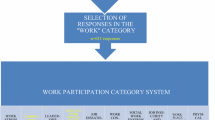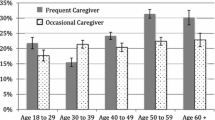Abstract
People who have tested positive for the expanded Huntington disease (HD) gene who are not yet diagnosed (pre-HD) and their companions report subtle changes in ability of people with pre-HD to do their jobs. However, it is not known whether they attribute these changes to HD. Semi-structured telephone interviews were analyzed from seven persons with pre-HD at different estimated points from diagnosis and six companions. Data were analyzed using qualitative analysis methods. Participants made attributions related to health, work, and temperament. Only one participant attributed a change to HD. The process of forming attributions was demonstrated through symptom monitoring and comparison of participants with pre-HD to others with and without HD. Participants also expressed uncertainty regarding how to make attributions. Attributions influence coping procedures, including whether to seek and accept medical treatment. In persons with prodromal HD the relationship between attributions and use of coping strategies for symptoms that interfere with job functioning is unknown.
Similar content being viewed by others
References
Adam, O., & Jankovic, J. (2008). Symptomatic treatment of Huntington disease. Neurotherapeutics, 5(2), 181–197.
Aujoulat, I., Marcolongo, R., Bonadiman, L., & Deccache, A. (2008). Reconsidering patient empowerment in chronic illness: a critique of models of self-efficacy and bodily control. Social Science & Medicine, 66(5), 1228–1239.
Baumann, L. J., Zimmerman, R. S., & Leventhal, H. (1989). An experiment in common sense: education at blood pressure screening. Patient Education and Counseling, 14(1), 53–67.
Bloch, M., Adam, S., Wiggins, S., Huggins, M., & Hayden, M. R. (1992). Predictive testing for Huntington disease in Canada: the experience of those receiving an increased risk. American Journal of Medical Genetics, 42(4), 499–507.
Broadbent, E., Ellis, C. J., Thomas, J., Gamble, G., & Petrie, K. J. (2009). Further development of an illness perception intervention for myocardial infarction patients: a randomized controlled trial. Journal of Psychosomatic Research, 67(1), 17–23.
Buchman, A., Boyle, P., Wilson, R., Fleischman, D., Leurgans, S., & Bennett, D. (2009). Association between late-life social activity and motor decline in older adults. Archives of Internal Medicine, 169(12), 1139–1146.
Caserta, M., Bannon, Y., Fernandez, F., Giunta, B., Schoenberg, M., & Tan, J. (2009). Normal brain aging: clinical, immunological, neuropsychological, and neuroimaging features. International Review of Neurobiology, 84, 1–19.
Chen, S. L., Tsai, J. C., & Lee, W. L. (2009). The impact of illness perception on adherence to therapeutic regimens of patients with hypertension in Taiwan. Journal of Clinical Nursing, 18(15), 2234–2244.
Davis, L. L. (2001). Assessing functional ability in persons with dementia: using family caregivers as informants. Journal of Neuroscience Nursing, 33(4), 194–195. 200–202.
Decruyenaere, M., Evers-Kiebooms, G., Cloostermans, T., Boogaerts, A., Demyttenaere, K., Dom, R., et al. (2003). Psychological distress in the 5-year period after predictive testing for Huntington’s disease. European Journal of Human Genetics: EJHG, 11(1), 30–38.
de Ridder, D. T., Theunissen, N. C., & van Dulmen, S. M. (2007). Does training general practitioners to elicit patients’ illness representations and action plans influence their communication as a whole? Patient Education and Counseling, 66(3), 327–336.
Duncan, R. E., Gillam, L., Savulescu, J., Williamson, R., Rogers, J. G., & Delatycki, M. B. (2008). “You’re one of us now”: Young people describe their experiences of predictive genetic testing for Huntington disease (HD) and familial adenomatous polyposis (FAP). American Journal of Medical Genetics.Part C, Seminars in Medical Genetics, 148C(1), 47–55.
Frostholm, L., Fink, P., Oernboel, E., Christensen, K., Toft, T., Olesen, F., et al. (2005). The uncertain consultation and patient satisfaction: the impact of patients’ illness perceptions and a randomized controlled trial on the training of physicians’ communication skills. Psychosomatic Medicine, 67(6), 897–905.
Godoy-Izquierdo, D., Lopez-Chicheri, I., Lopez-Torrecillas, F., Velez, M., & Godoy, J. F. (2007). Contents of lay illness models dimensions for physical and mental diseases and implications for health professionals. Patient Education and Counseling, 67(1–2), 196–213.
Grimbergen, Y. A. M., & Roos, R. A. C. (2003). Therapeutic options for Huntington’s disease. Current Opinion in Investigational Drugs, 4(1), 51–54.
Hannan, A. (2005). Novel therapeutic targets for Huntington’s disease. Expert Opinion on Therapeutic Targets, 9(4), 639–650.
Helder, D. I., Kaptein, A. A., van Kempen, G. M., van Houwelingen, J. C., & Roos, R. A. (2001). Impact of Huntington’s disease on quality of life. Movement Disorders, 16(2), 325–330.
Helder, D. I., Kaptein, A. A., Van Kempen, G. M., Weinman, J., Van Houwelingen, H. C., & Roos, R. A. (2002). Living with Huntington’s disease: Illness perceptions, coping mechanisms, and patients’ well-being. British Journal of Health Psychology, 7(Part 4), 449–462.
Hogarth, P. (2003). Huntington’s disease: a decade beyond gene discovery. Current Neurology and Neuroscience Reports, 3(4), 279–284.
Hoth, K. F., Paulsen, J. S., Moser, D. J., Tranel, D., Clark, L. A., & Bechara, A. (2007). Patients with Huntington’s disease have impaired awareness of cognitive, emotional, and functional abilities. Journal of Clinical and Experimental Neuropsychology, 29(4), 365–376.
Jurgens, C. Y., Hoke, L., Byrnes, J., & Riegel, B. (2009). Why do elders delay responding to heart failure symptoms? Nursing Research, 58(4), 274–282.
Kaptein, A. A., Scharloo, M., Helder, D. I., Snoei, L., van Kempen, G. M., Weinman, J., et al. (2007). Quality of life in couples living with Huntington’s disease: the role of patients’ and partners’ illness perceptions. Quality of Life Research, 16(5), 793–801. doi:10.1007/s11136-007-9194-4.
Kloeppel, S., Chu, C., Tan, G. C., Draganski, B., Johnson, H., Paulsen, J. S., et al. (2009). Automatic detection of preclinical neurodegeneration: presymptomatic Huntington disease. Neurology, 72(5), 426–431.
Langbehn, D. R., Brinkman, R. R., Falush, D., Paulsen, J. S., Hayden, M. R., & International Huntington’s Disease Collaborative Group. (2004). A new model for prediction of the age of onset and penetrance for Huntington’s disease based on CAG length. Clinical Genetics, 65(4), 267–277.
Lawson, V., & Harvey, J. (2009). The importance of health belief models in determining self-care behaviour in diabetes. Diabetic Medicine, 26(1), 5–13.
Lerdal, A., Celius, E. G., & Moum, T. (2009). Perceptions of illness and its development in patients with multiple sclerosis: a prospective cohort study. Journal of Advanced Nursing, 65(1), 184–192.
Leventhal, E. A. (1984). Aging and the perception of illness. Research on Aging, 6(1), 119–135.
Leventhal, H., Meyer, D., & Nerenz, D. (1980). The common sense representation of illness danger. In S. Rachman (Ed.), Contributions to medical psychology, vol. 2 (pp. 7–30). New York: Pergamon.
Leventhal, H., Nerenz, D. R., & Steele, D. J. (1984). Illness representations and coping with health threats. In A. Baum & J. Singer (Eds.), A handbook of psychology and health, vol. 4 (pp. 219–252). Hillsdale: Erlbaum.
Leventhal, H., Leventhal, E. A., & Nguyen, T. V. (1985). Reactions of families to illness: theoretical models and perspectives. In D. C. Turk & R. D. Kerns (Eds.), Health, illness and families: A life-span perspective (pp. 108–145). New York: Wiley.
Leventhal, E. A., Leventhal, H., Schaefer, P., & Easterling, D. (1993). Conservation of energy, uncertainty reduction, and swift utilization of medical care among the elderly. Journal of Gerontology, 48(2), 78–86. doi:10.1093/geronj/48.2.P78.
Leventhal, E. A., Easterling, D., Leventhal, H., & Cameron, L. (1995). Conservation of energy, uncertainty reduction, and swift utilization of medical care among the elderly: study II. Medical Care, 33(10), 988–1000.
Leventhal, H., Leventhal, E. A., & Contrada, R. J. (1998). Self-regulation, health, and behavior: a perceptual-cognitive approach. Psychology & Health, 13(4), 717–733. doi:10.1080/08870449808407425.
Leventhal, H., Kelly, K., & Leventhal, E. A. (1999). Population risk, actual risk, perceived risk, and cancer control: a discussion. Journal of the National Cancer Institute. Monographs, 1999(25), 81–85.
McCabe, M. P., Roberts, C., & Firth, L. (2008). Work and recreational changes among people with neurological illness and their caregivers. Disability and Rehabilitation, 30(8), 600–610.
Morse, J. M. (1994). Designing funded qualitative research. In N. K. Denzin & Y. S. Lincoln (Eds.), Handbook of qualitative research (pp. 220–235). Thousand Oaks: Sage.
Morse, J. M., & Niehaus, L. (2009). Mixed method design. Principles and procedures. Walnut Creek: Left Coast Press.
Myers, R. H. (2004). Huntington’s disease genetics. NeuroRx: The Journal of the American Society for Experimental NeuroTherapeutics, 1(2), 255–262.
OMIM. (2009). Huntington disease. Retrieved September 2, 2009, from http://www.ncbi.nlm.nih.gov/omim/.
Paulsen, J. S. (2009). Functional imaging in Huntington’s disease. Experimental Neurology, 216(2), 272–277.
Paulsen, J. S. (2010). Early detection of Huntington’s disease. Future Neurology, 5(1), 85–104.
Paulsen, J. S., Hayden, M., Stout, J. C., Langbehn, D. R., Aylward, E., Ross, C. A., et al. (2006). Preparing for preventive clinical trials: the predict-HD study. Archives of Neurology, 63(6), 883–890.
Paulsen, J. S., Langbehn, D. R., Stout, J. C., Aylward, E., Ross, C. A., Nance, M., et al. (2008). Detection of Huntington’s disease decades before diagnosis: the predict-HD study. Journal of Neurology, Neurosurgery and Psychiatry, 79(8), 874–880.
Paulsen, J., Wang, C., Duff, K., Barker, R., Nance, M., Beglinger, L., et al. (2009). Challenges assessing functional outcomes in early Huntington’s disease [Abstract]. Clinical Genetics, 76(S1), A20.
Penziner, E., Williams, J. K., Erwin, C., Bombard, Y., Wallis, A., Beglinger, L. J., et al. (2008). Perceptions of discrimination among persons who have undergone predictive testing for Huntington’s disease. American Journal of Medical Genetics. Part B, Neuropsychiatric Genetics, 147(3), 320–325. doi:10.1002/ajmg.b.30600.
Petrie, K., Cameron, L., Ellis, C., Buick, D., & Weinman, J. (2002). Changing illness perceptions after myocardial infarction: an early intervention randomized controlled trial. Psychosomatic Medicine, 64(4), 580–586.
QSR International. (2000). NVivo. Victoria: Doncaster.
Quaid, K. A., & Wesson, M. K. (1995). Exploration of the effects of predictive testing for huntington disease on intimate relationships. American Journal of Medical Genetics, 57(1), 46–51.
Ranen, N. G., Lipsey, J. R., Treisman, G., & Ross, C. A. (1996). Sertraline in the treatment of severe aggressiveness in Huntington’s disease. Journal of Neuropsychiatry and Clinical Neurosciences, 8(3), 338–340.
Richards, F. (2004). Couples’ experiences of predictive testing and living with the risk or reality of Huntington disease: a qualitative study. American Journal of Medical Genetics.Part A, 126A(2), 170–182.
Sandelowski, M. (1995). Focus on qualitative methods. sample size in qualitative research. Research in Nursing Health, 18(2), 179–183.
Sandelowski, M. (2000). Focus on research methods. whatever happened to qualitative description? Research in Nursing Health, 23(4), 334–340.
The Huntington’s Disease Collaborative Research Group. (1993). A novel gene containing a trinucleotide repeat that is expanded and unstable on Huntington’s disease chromosomes. Cell, 72(6), 971–983.
Walker, F. O., & Raymond, L. A. (2004). Targeting energy metabolism in Huntington’s disease. Lancet, 364(9431), 312–313.
Warr, P. (2008). Work values: some demographic and cultural correlates. Journal of Occupational and Organizational Psychology, 81(4), 751–775.
Williams, J. K., Hamilton, R., Nehl, C., McGonigal-Kenney, M., Schutte, D., Sparbel, K., et al. (2007). “No one else sees the difference:” family members’ perceptions of changes in persons with preclinical huntington disease. American Journal of Medical Genetics. Part B, Neuropsychiatric Genetics, 144B(5), 636–641.
Williams, J., Skirton, H., Paulsen, J. S., Tripp-Reimer, T., Jarmon, L., McGonigal Kenney, M., et al. (2009). The emotional experiences of family carers in Huntington disease. Journal of Advanced Nursing, 65(4), 789.
Witjes-Ane, M. N., Mertens, B., van Vugt, J. P., Bachoud-Levi, A. C., van Ommen, G. J., & Roos, R. A. (2007). Longitudinal evaluation of “presymptomatic” carriers of Huntington’s disease. Journal of Neuropsychiatry and Clinical Neurosciences, 19(3), 310–317.
Acknowledgments
Dr. Jane Paulsen’s research is supported by the National Institutes for Health, National Institute of Neurological Disorders and Stroke (NS40068) and CHDI Foundation, Inc. The authors report no conflict of interest. We have full control of all primary data and agree to allow the journal to review such data if requested.
Author information
Authors and Affiliations
Corresponding author
Rights and permissions
About this article
Cite this article
Downing, N.R., Williams, J.K. & Paulsen, J.S. Couples’ Attributions for Work Function Changes in Prodromal Huntington Disease. J Genet Counsel 19, 343–352 (2010). https://doi.org/10.1007/s10897-010-9294-0
Received:
Accepted:
Published:
Issue Date:
DOI: https://doi.org/10.1007/s10897-010-9294-0




